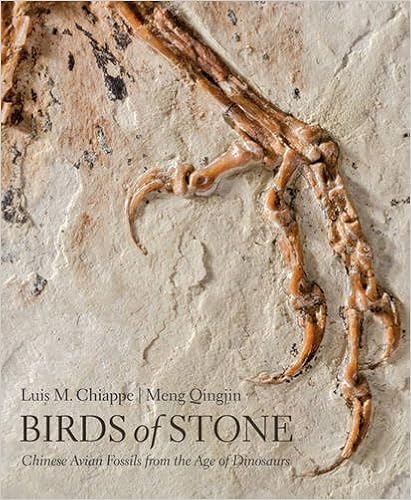It's a good year in the book department for aficionados of fossil birds, as at least two major volumes on the subject have been released. In this post I will review the first of these two, saving the other for a later date.
Birds of Stone, authored by renowned paleornithologists Luis Chiappe and Meng Qingjin, focuses on the diverse and fantastically-preserved avifauna of the Early Cretaceous Jehol Group in China.
The book is, in part, intended to be a photographic gallery featuring the numerous fossil bird specimens that have been unearthed from the Jehol, and in this it excels. Page after page for the first two-thirds of the book, readers are treated to high-resolution images of Jeholornis, Sapeornis, Confuciusornis, Yanornis, Longipteryx, Zhouornis, unnamed enantiornithines in abundance, and more. Take note: we now have high-res photographs of Xinghaiornis! An interesting tidbit is that one enantiornithine specimen figured, preserved with rectrices almost twice the length of its body, is labeled "Junornis houi", a name thus far unpublished in technical literature.
Many of the photographs are given single- or double-page spreads. Close-ups of teeth, claws, feathers, gut contents, and embryos are all presented in incredible detail. Specimens shown under ultraviolet light reveal foot scales and wing patagia. Considering that many Jehol fossils have only been perfunctorily described and figured in the literature despite their scientific importance, the images in this book should be valuable not only for their aesthetic appeal, but also for their potential as references (particularly for paleoartists).
Continuous text descriptions of the fossils accompany the gallery, putting the pretty pictures in context. Information is provided on what we know about the anatomy and paleobiology of Jehol birds, but it is the last third of the book where the text takes center stage. Here, the book gives a broader overview of avialan evolution, covering topics such as the diversity of Mesozoic birds, the origins of avian flight, and the scientific significance of the Jehol Group. There are fewer full-page photographic spreads in this section, though it is nonetheless well-illustrated with images featuring, in addition to more bird fossils, non-dinosaurian specimens from the Jehol and fossils of feathered non-avialan dinosaurs. The text shines in its clear writing that uses minimal technical language to explain its concepts, which should make the book fairly accessible to interested laypeople. (One minor lapse: at one point a screamer is used as a reference for size with no explanation. I would not expect most laypeople to be familiar with screamers.)
As a summary of the state of the art, Birds of Stone does well. The most recently-named taxon mentioned in the text is Chiappeavis, making the book up to date through the end of 2015. Possibly of interest is that the authors speculate about the possibility that Sapeornis used its large talons to apprehend animal prey, while acknowledging that known gut contents of this bird consist of seeds. Interestingly, the authors express support for synonymizing Iteravis and Gansus zheni, an idea that has been suggested by Mickey Mortimer but has yet to appear in scientific literature. (Though unlike Mortimer, they retain the taxon in question as part of the genus Gansus.)
Did I find any fault with the book? The text is somewhat repetitive at times. For instance, the potential scientific significance and controversial phylogenetic position of Zhongornis (a short-tailed bird that lacks a pygostyle) is explained at least three separate times (not merely mentioned or referenced, but given an entire paragraph in each instance), and the same is true of various other subjects covered. There were a few moments while I was reading when I stopped and checked that I hadn't mistakenly flipped to an earlier part of the book that I'd already read.
As far as nitpicky details go, the outdated term "Tertiary" is used. The pterosaur Jeholopterus and the mammal Juramaia are incorrectly said to be part of the Jehol biota. (Both are instead from the Late Jurassic Tiaojishan Formation.) It is implied that all ornithomimosaurs, therizinosaurs, and oviraptorosaurs possessed pygostyles, even though this is not the case. (A pygostyle is only known in Deinocheirus among ornithomimosaurs and in Beipiaosaurus among therizinosaurs. It is more widespread in oviraptorosaurs, but not universal.)
Despite my quibbles, the photographs contained in this volume are worth the price of admission on their own, and I would recommend Birds of Stone to anyone interested in paleornithology. The informative and layperson-friendly writing is icing on the cake. Just make certain to keep tabs on what page you are on, because you may find some difficulty doing so by the text alone.
Sunday, November 13, 2016
Subscribe to:
Post Comments (Atom)









No comments:
Post a Comment